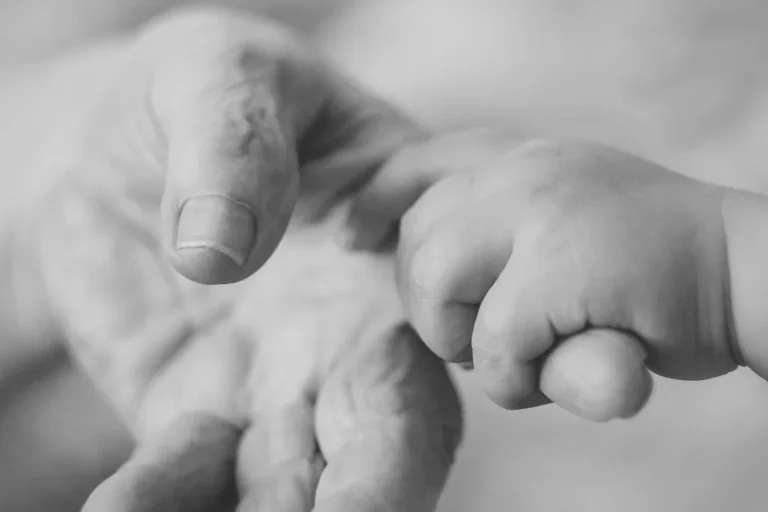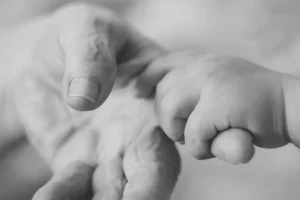Attachment-Breaks and Trauma Symptoms

In early infancy, a breach in attachment is perceived by the baby as life-threatening. Such early childhood experiences have profound effects on later life and can lead to a range of trauma symptoms and adaptive survival styles later in life.
This article explores how traumatic attachment experiences affect our emotional wellbeing later in life and the possibilities for renegotiating trauma.
Dependency and Distress of Separation in Early Childhood
Note: The trauma response “Attachment Cry” – in its different forms – is usually related to Developmental Trauma in early childhood rather than shock trauma.
The Attachment Cry – Emergency Reaction to Attachment Break
The attachment cry is the infant’s cry for help/protest response to breaking the attachment to the mother. Due to its high dependency on the mother, any separation represents a life-threatening danger for the infant and is associated with a very high level of stress. The state caused by separation activates circuits similar to physical pain within the baby. The baby cries for his caregiver, which in turn regulates the child by touch, feeding and other forms of social engagement.
Physiological Reactions to a Break in Attachment
Depending on the situation / prior experiences, the baby may react in different ways:
- Protest
Related to high levels of stress, a sympathetic fight response – this is related to hyperactivity of the nervous system- In adulthood related to panic attacks
- Despair
After a high level of stress, the baby has given up and lost hope. This is a parasympathetic shutdown response, related to underactivity of the nervous system.- In adulthood this is related to depression.
Note that in the first few years the baby requires co-regulation of the adult. Until the age of 3 or 4 the “calming down” is most likely a sign of despair and giving up as he baby has not yet developed the ability to self-regulate downward from of a state of high stress.
“Disruptions of attachment during infancy can lead to lasting neurobiological changes… Lack of parental response in separation typically results in biphasic protest / despair response that may be correlated with hyperactivity or underactivity of neurotransmitter systems. In humans, damage related to protest may lead to panic attacks in adulthood, while excessive exposure to despair in infancy may give rise to cyclical depressions in adults.”
Bessel van der Kolk, MD Boston University School of Medicine(Quote from his book “Psychological Trauma”)
Trauma Symptoms in Adults (PTSD, Developmental Trauma)
In adults, the attachment cry trauma response provides the background for a number of trauma symptoms and adaptive survival styles.
- Global High Activation – Generalised Arousal
- Lack of Autonomy – Dependency on Other People
- Fawn Response – Please and appease behaviour
Global High Activation
Global High Activation may be a remnant of high traumatic arousal in early childhood. This can be due to a break in attachment and the strong sense of anger and panic this abandonment caused in the baby. Trauma symptoms in terms of overall activation are similar to high activation based on shock trauma (PTSD).
Lack of Autonomy – Dependency on Other People
Dependency behaviour is the closest adult equivalent to the original attachment cry. Due to lack of own resources, the person is looking for help from others to get out trouble. Besides possible roots in early trauma, the dependent strategy may develop based on parental neglect and abuse. Please note overprotection and lack of challenge may also contribute to this strategy (compare Simonelli, A. and Parolin, M., 2017).
Such individuals are generally high in trait agreeableness and a have strong need to stay in close / merging contact. Strongly accentuated personalities of this type may get diagnosed as a dependent personality disorder (ICD-10 code F60.7). According to the ICD-10, this personality type is “characterised by pervasive passive reliance on other people to make one’s major and minor life decisions, great fear of abandonment, feelings of helplessness and incompetence, passive compliance with the wishes of elders and others, and a weak response to the demands of daily life.” They often show a tendency to transfer responsibility to other people. See below for treatment of the according symptoms.
Fawn Response – Please and Appease / Submission
Please and appease behaviour (also called Fawn-Response) may be seen as a strategy to avoid a break in the attachment situation. Later in life, this may result in generalised pleasing and appeasing behaviour. Virginia Satir called this personality type “Placator”. These individuals are very dependent on not losing the good relationship to others. They make sure that they sense and anticipate the needs of others and fulfil them. While this behaviour is indicates being stuck in the attachment phase, the behavioural strategies to cope with the situation originates from a later phase in childhood, where the person has a larger range of behaviours available. Symptoms and treatment of this type trauma are discussed in a separate article Fawn-Response.
Reprocessing Trauma – Getting from Dependency to Autonomy
Working with dependency from others needs to address the underlying fears of attachment break. This means establishing a relationship to abandoned parts in the here and now and strengthen a range of Ego Functions. One typically starts with building Ego Functions centering, boundaries and later moving into functions like self assertion, positioning and interpersonal skills.
- Reprocessing attachment trauma / Containment of emotions
- Sorgfältige Bearbeitung bestimmter Traumata, die durch einen Bruch in Beziehungen / Bindungsbeziehungen gekennzeichnet waren (dazu können beispielsweise Krankenhausbesuche in der frühen Kindheit gehören).
- Umgang mit emotionalem Stress bei Traumata mit erheblichen Bindungs-/Bindungsbrüchen.
- Building healthy attachment / bonding / contact behaviours
- Reactivating attachment instinct behaviour (Bodynamic attachment exercises)
- Reactivating muscles from Need phase (Bodynamic need exercises)
- Rebuilding the relationship to abandoned parts of the personality
- Work with parts who have withdrawn to cope with abandonment, loneliness or are reacting with anger towards it (e.g. work with parts like Inner Child Work according to Dr. Margret Paul or Internal Family Systems)
- This usually also includes working with the Inner Critic, the part which thinks one is not good enough unless one is in a merged attachment relationship. There may be further parts, which are not happy with giving up one’s own personality.
- Establish self care in the here and now.
- Strengthening the Body Ego and Individual Ego to strengthen the core of personality
- Strengthen Centering, Grounding, Boundaries – Bodynamic Exercises to strengthen these Ego Functions from the muscular system.
- Strengthen Self Assertion, Positioning, Social Balance and Interpersonal Skills to reposition in life today. Bodynamic Exercises to strengthen these Ego Functions from the muscular system.
- Practical development of contact with other people
- Learn to keep your center and your boundaries in social contact.
- Develop and practice self assertion
- Post-traumatic growth: Re-Evaluate Self Concept and Identity
- Developing a self concept / identity in line with the current situation as an adult, who generally can take care of oneself.
In psychotherapeutic work with dependency on other people, the underlying fears of a break in the bond must be addressed.
Sources and Further Reading
- Simonelli, Alessandra & Parolin, Micol. (2017). Dependent Personality Disorder. 10.1007/978-3-319-28099-8_578-1. https://www.researchgate.net/publication/318820360_Dependent_Personality_Disorder
- van der Kolk, B. (1987). Psychological trauma. Washington, DC: American Psychiatric Press, Inc.




